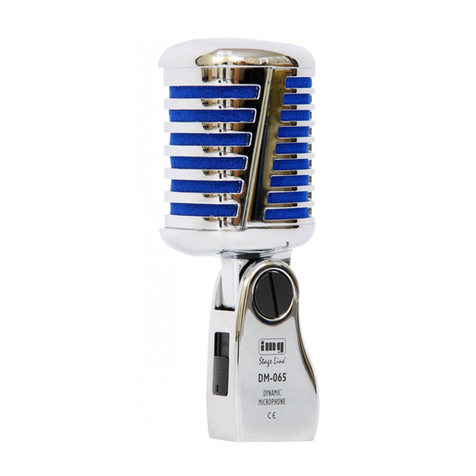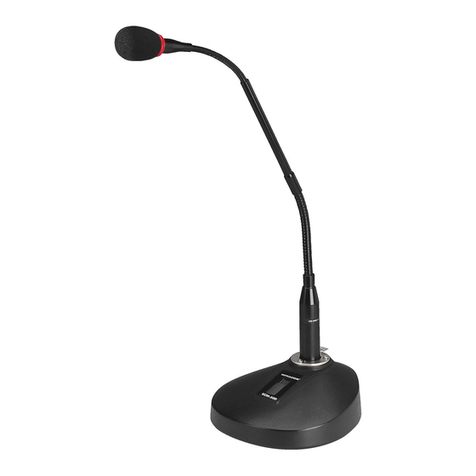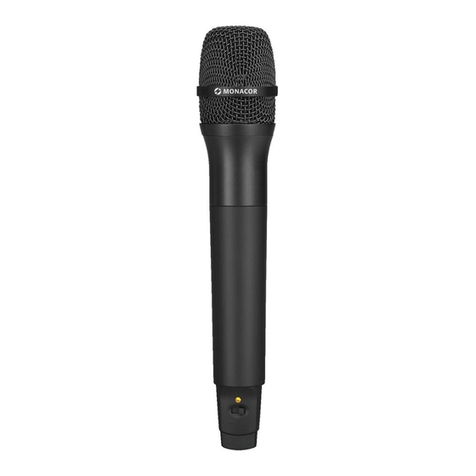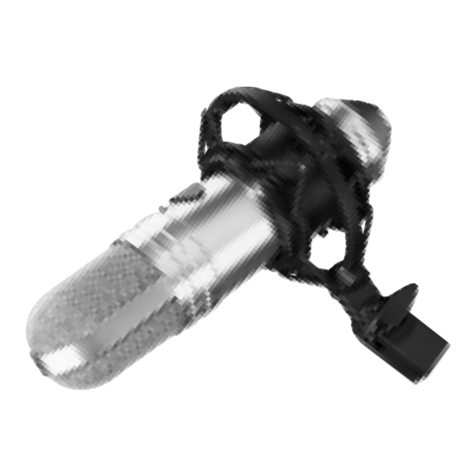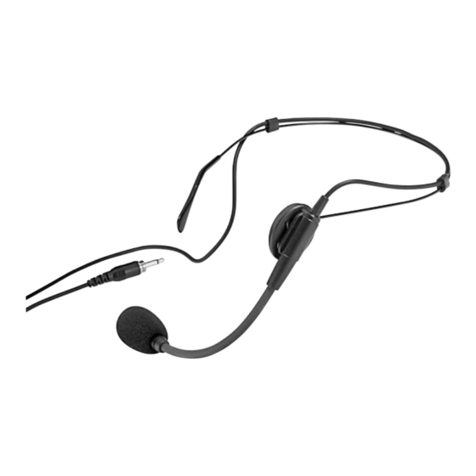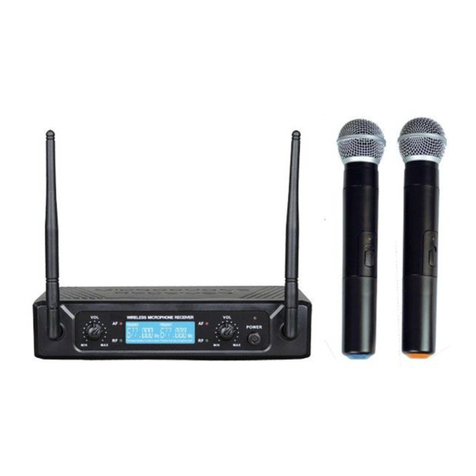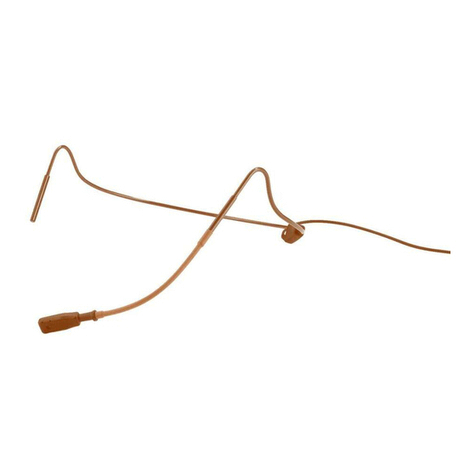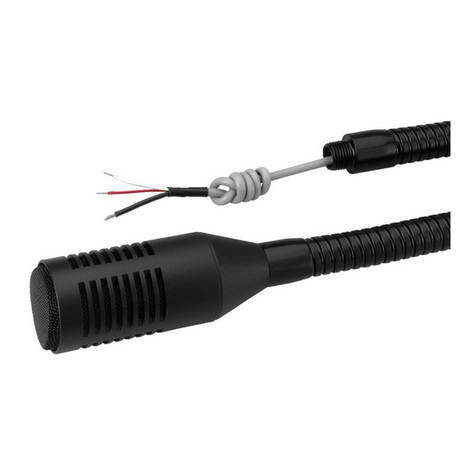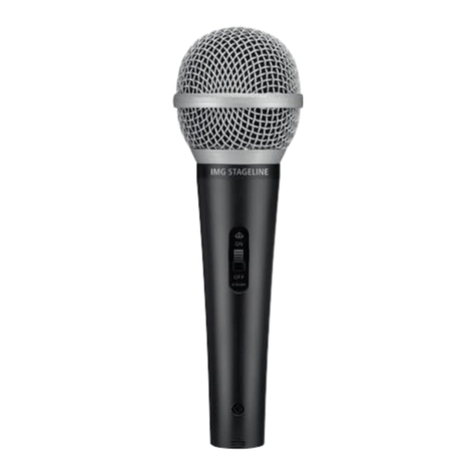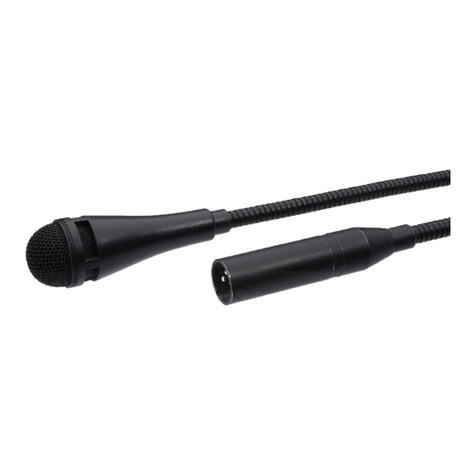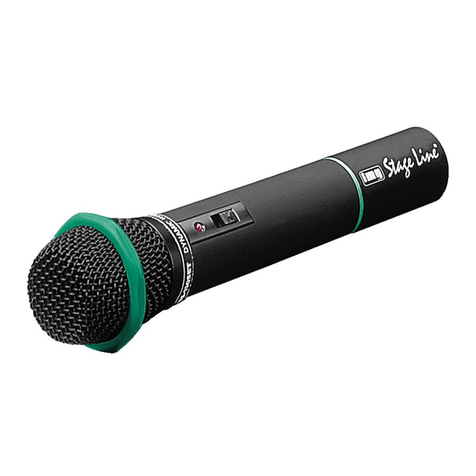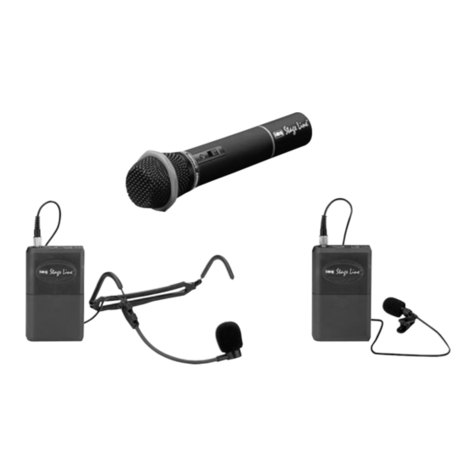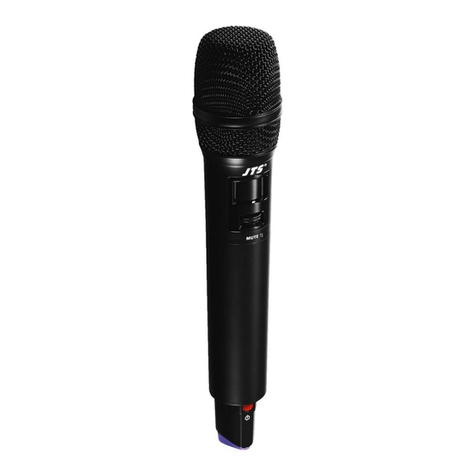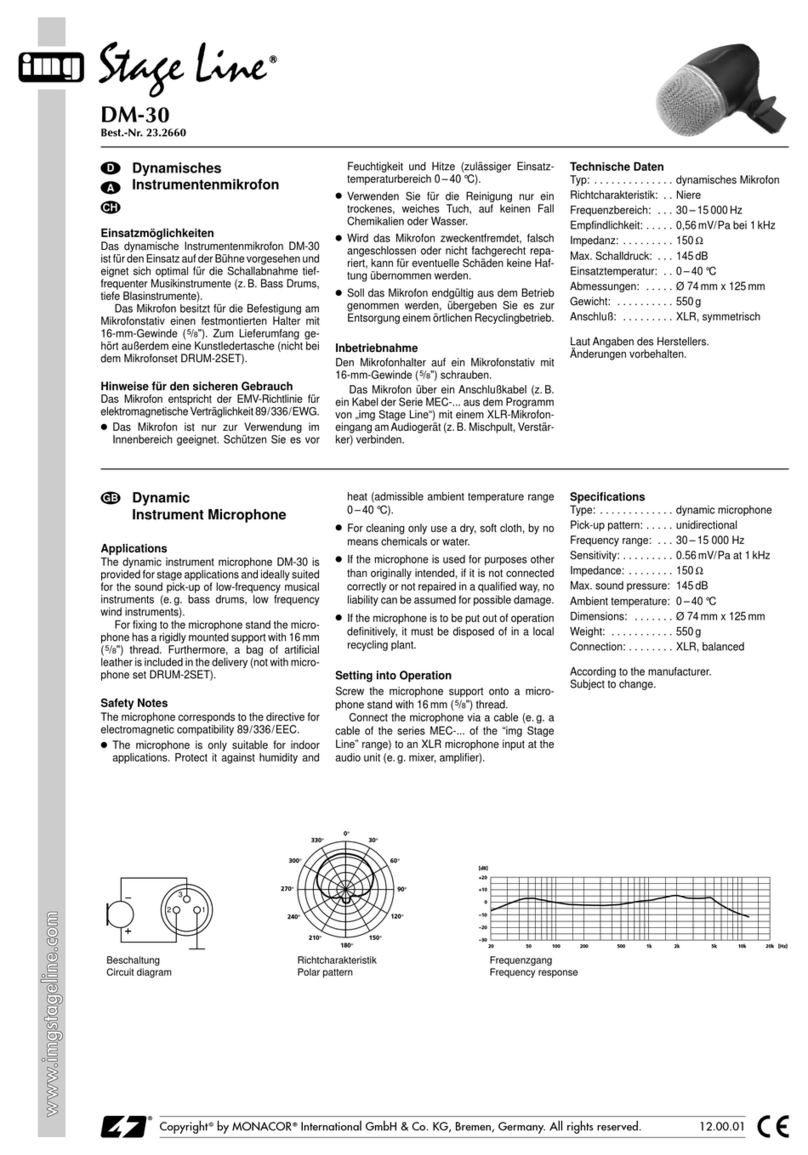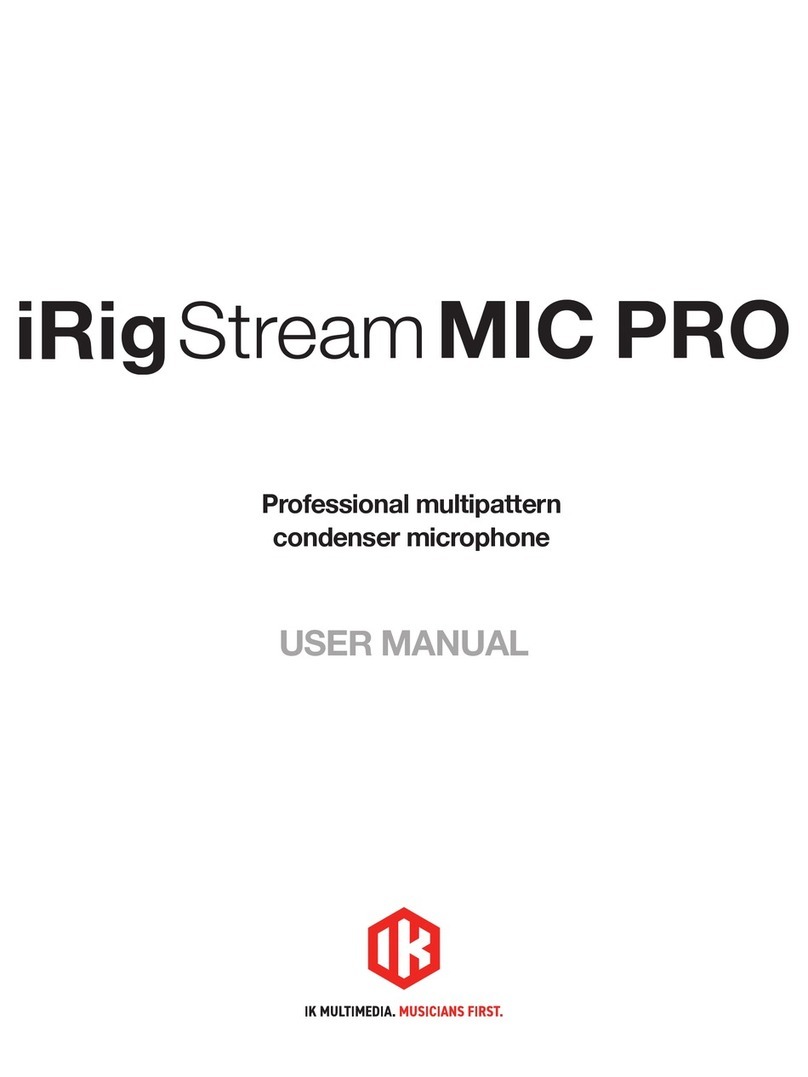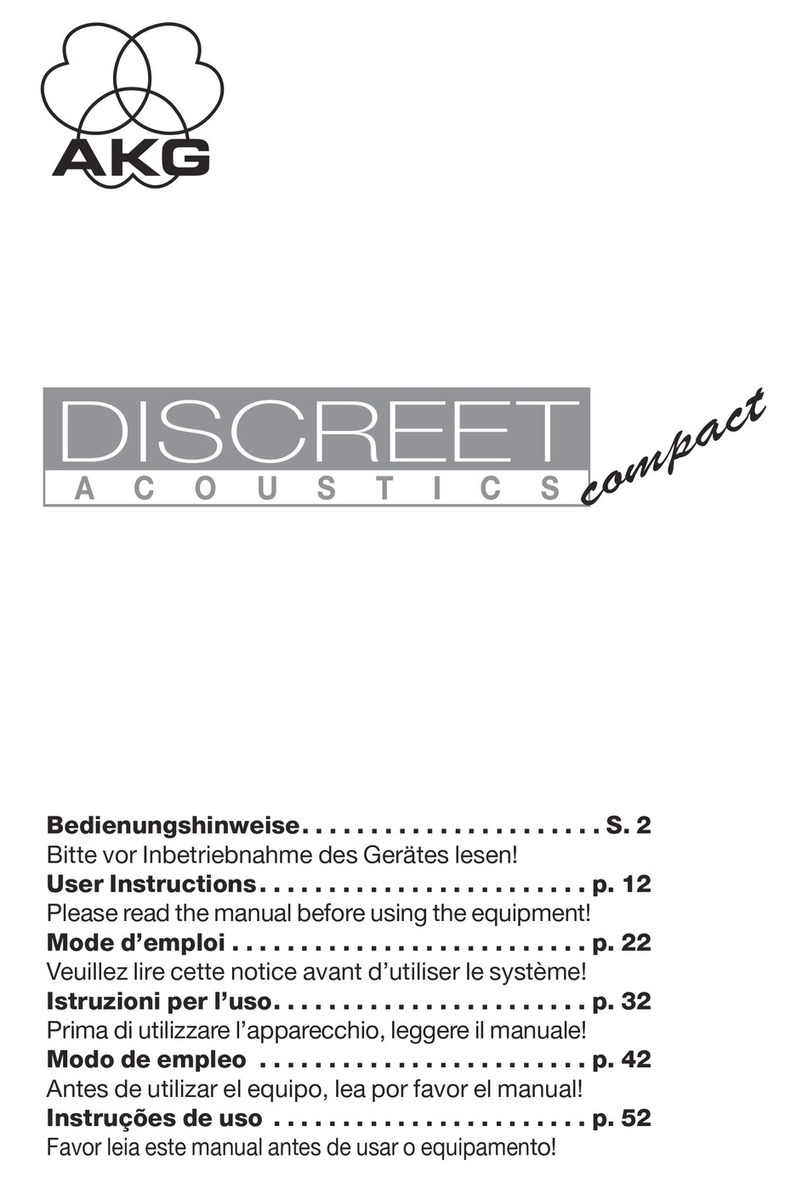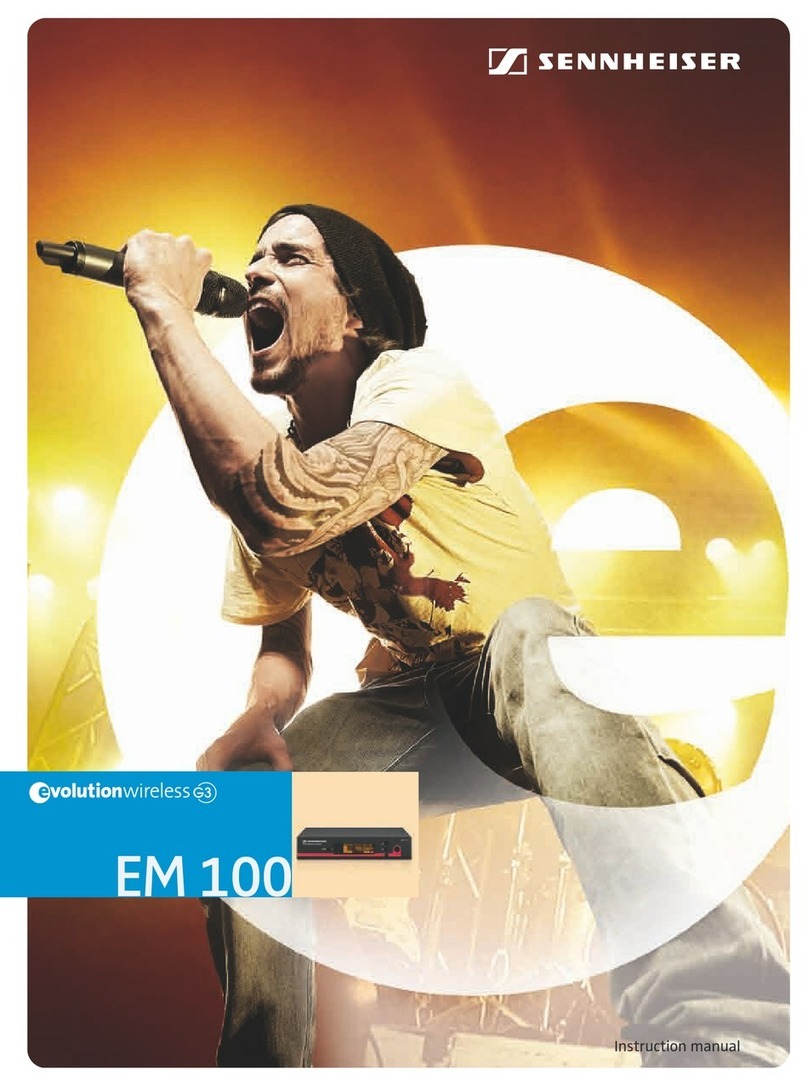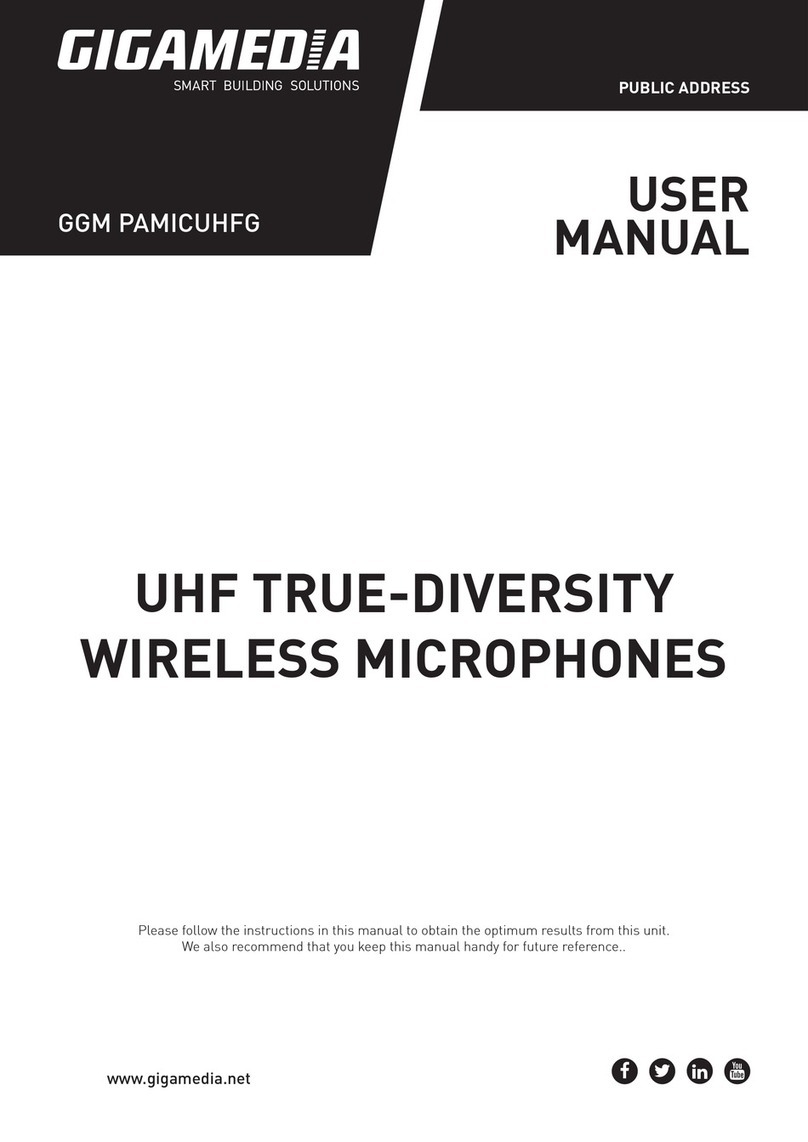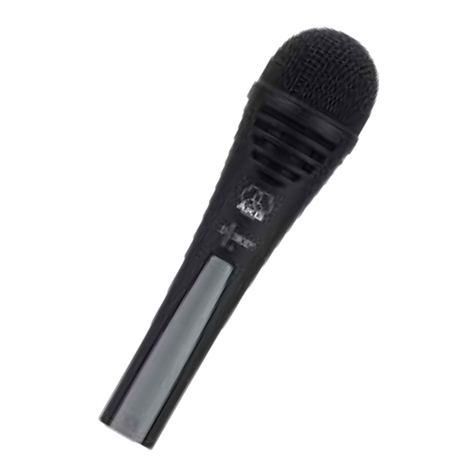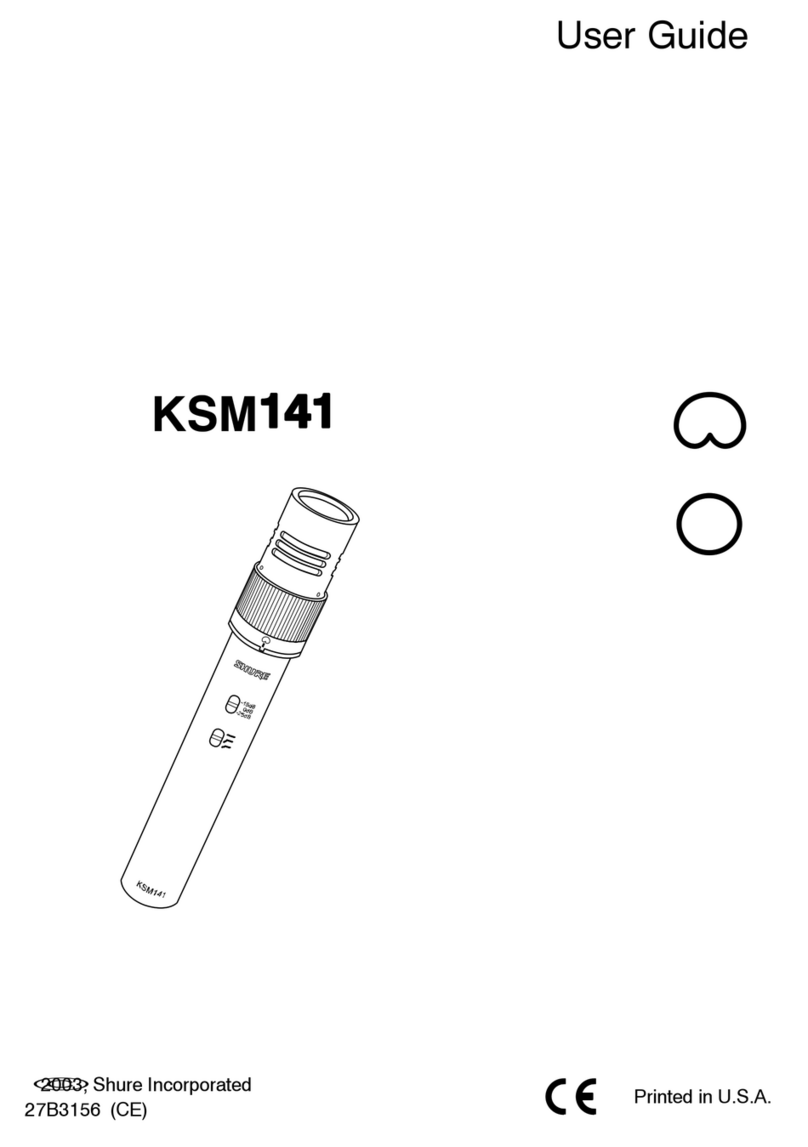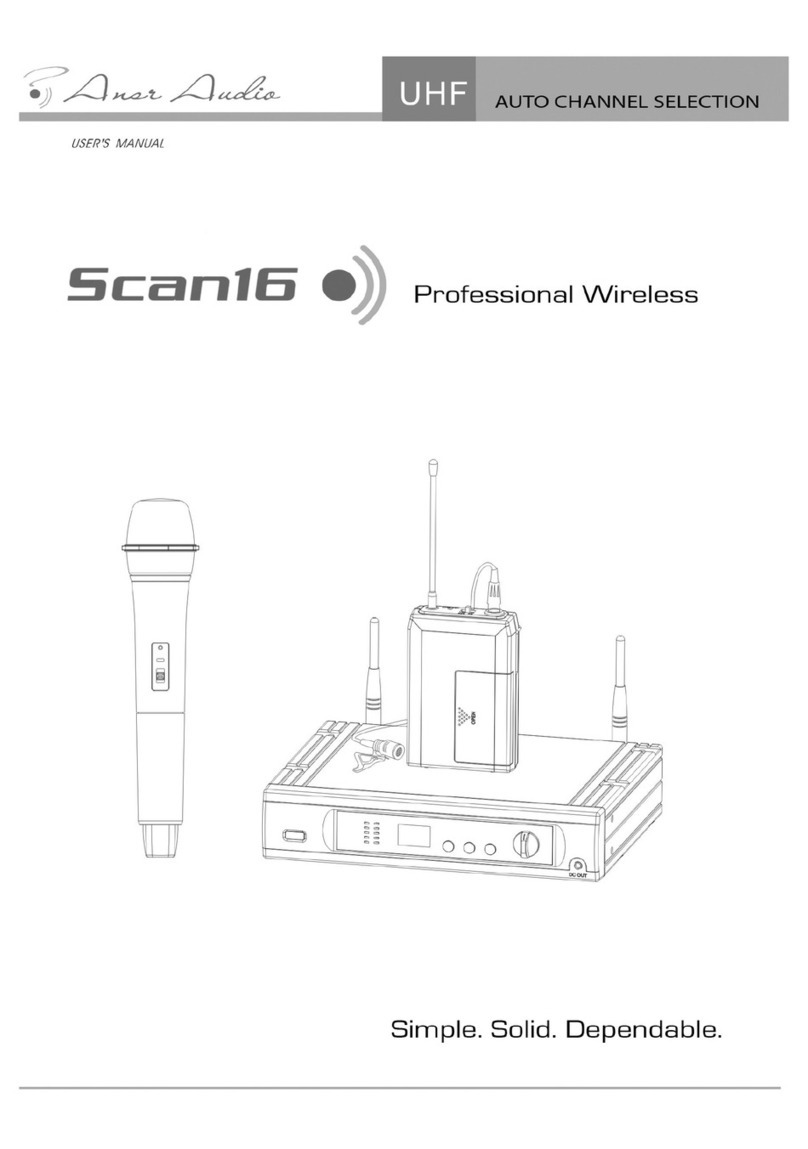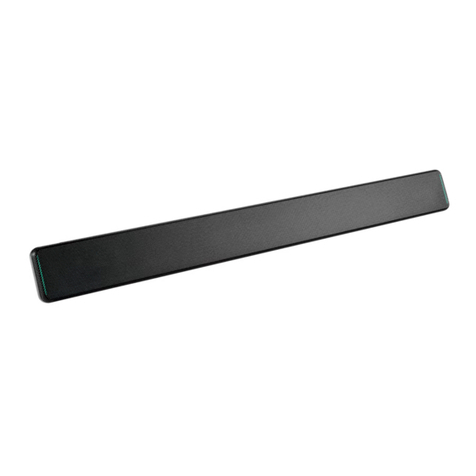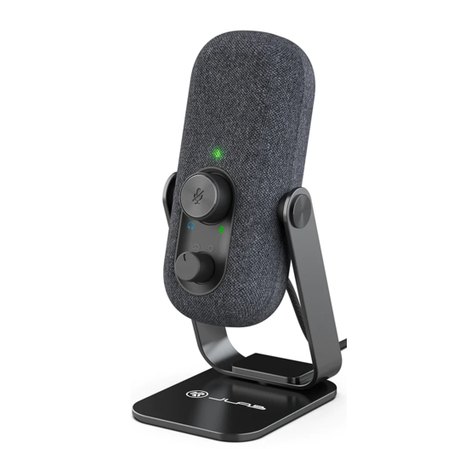
ECM-140
Best.-Nr. 23.4350
wwwwww..iimmggssttaaggeelliinnee..ccoomm
Copyright©by MONACOR NTERNAT ONAL GmbH & Co. KG, Bremen, Germany. All rights reserved. A-0614.99.02.04.2008
®
M crophone électret à
grande membrane
1 Poss b l tés dʼut l sat on
Le microphone EC -140 avec une membrane
25,4 mm (1") extrêmement fine, avec revêtement or,
est conçue pour des utilisations professionnelles en
studio et en direct. Il est tout aussi bien adapté pour
des prises de son dʼinstruments que pour des appli-
cations de chant et discours. Pour le fonctionne-
ment, le microphone requiert une alimentation
fantôme de 48 V.
Sont livrés un coffret, une bonnette de protection
et un support atténuateur de vibrations (araignée).
2 Conse ls dʼut l sat on mportants
Le microphone répond à toutes les directives
nécessaires de lʼUnion Européenne et porte donc le
symbole .
GLe microphone nʼest conçu que pour une utilisa-
tion en intérieur. Protégez-le dʼune humidité éle-
vée et de la chaleur (plage de température de
fonc tionnement autorisée : 0 – 40 °C).
GPour le nettoyer, utilisez uniquement un chiffon
sec et doux, en aucun cas de produits chimiques
ou dʼeau.
GNous déclinons toute responsabilité en cas de
dommages matériels ou corporels résultants si le
microphone est utilisé dans un but autre que celui
pour lequel il a été conçu, sʼil nʼest pas correcte-
ment branché ou sʼil nʼest pas réparé par une per-
sonne habilitée ; en outre, la garantie deviendrait
caduque.
3Fonct onnement
1) Vissez lʼaraignée sur un pied doté dʼun filetage
15,9 mm (5/8") ou, avec un adaptateur fileté, sur
un pied avec un filetage 9,5 mm (3/8"). Appuyez
sur les deux étriers métalliques ensemble dans le
support et insérez le microphone.
2) Pour diriger le microphone, desserrez la vis de
réglage sur le support, positionnez le micro-
phone de telle sorte que le côté avec le symbole
soit en direction de la source audio (lʼaxe du
microphone est vertical par rapport à la direction
principale du son) puis revissez la vis.
3) Reliez le microphone via un cordon avec fiche
XLR mâle (p.ex. un cordon de la série EC- de
“img Stage Line”) à une entrée micro de lʼappareil
audio utilisé (par exemple table de mixage). Lʼen-
trée micro doit avoir une alimentation fantôme
48 V. Si lʼappareil audio ne délivre pas dʼalimenta-
tion fantôme, reliez le microphone via un appareil
à alimentation fantôme (par exemple E A-3 de
“img Stage Line”) à lʼappareil audio.
4) Si besoin, placez la bonnette. La bonnette ou une
protection anti-pop disponible en option (par
exemple WS-100 de “img Stage Line”) empêche
lors dʼapplications de chant ou de discours, non
seulement une accentuation excessive de sons
explosifs mais protège aussi le microphone de
lʼhumidité de la respiration.
Lorsque le microphone est définitivement
retiré du service, vous devez le déposer
dans une usine de recyclage adaptée pour
contribuer à son élimination non polluante.
5) Pour éliminer les fréquences basses (p. ex. bruits
de pas), allumez le filtre passe-haut : mettez lʼin-
terrupteur du filtre sur la position .
6) Pour des pressions sonores très élevées (par
exemple dans le cas dʼune prise de son proche
de batterie ou de cuivres), une atténuation de
10 dB peut être allumée pour protéger les
appareils suivants dʼune surcharge. ettez lʼin-
terrupteur dʼatténuation sur la position “
-
10 dB”.
4Caractér st ques techn ques
Système : . . . . . . . . . . . . . . récepteur à gradient de
pression/cardioïde
Filtre passe-haut : . . . . . . . . 150 Hz, 6 dB/octave
nterrupteur
atténuation : . . . . . . . . . . . .
-
10 dB
Sensibilité : . . . . . . . . . . . . . 15 mV/Pa à 1 kHz
mpédance : . . . . . . . . . . . . 200
Ω
Pression sonore max : . . . . 130 dB pour taux de distorsion
0,5 %
Rapport signal/bruit : . . . . . 80 dB (filtre A)
Alimentation : . . . . . . . . . . . alimentation fantôme 48 ±4 V
Branchement : . . . . . . . . . . XLR, symétrique
Configuration contacts :
1 = blindage/alimentation fantôme
-
2 = signal+/alimentation fantôme+
3 = signal
-
/alimentation fantôme+
Dimensions : . . . . . . . . . . . . Ø 50 mm x 195 mm
Poids : . . . . . . . . . . . . . . . . . 470 g
Tout droit de modification réservé.
M crofono a elettrete
a grande membrana
1 Poss b l tà dʼ mp ego
Il microfono EC -140 con la sua membrana di
25,4 mm (1"), estremamente sottile, placata dʼoro, è
stato realizzato per impieghi professionali negli
studi di registrazione e dal vivo; è adatto sia per pre-
levare il suono da strumenti musicali che per appli-
cazioni di canto e di lingua parlata. Il microfono fun-
ziona con unʼalimentazione phantom di 48 V.
Il kit comprende una valigetta, un supporto del
microfono che riduce le vibrazioni (spider) e una
spugna antivento.
2 Avvertenze d s curezza
Il microfono è conforme a tutte le direttive richieste
dellʼUE e pertanto porta la sigla .
GUsare il microfono solo allʼinterno di locali. Pro-
teggerlo dallʼ umidità e dal calore (temperatura
dʼimpiego ammessa fra 0 e 40 °C).
GPer la pulizia usare solo un panno morbido, asciut-
to; non impiegare in nessun caso prodotti chimici
o acqua.
GNel caso dʼuso improprio, di collegamenti sba -
gliati o di riparazione scorretta del microfono, non
si assume nessuna responsabilità per eventuali
danni consequenziali a persone o a cose e non si
assume nessuna garanzia per il microfono.
Se si desidera eliminare il microfono defi-
nitivamente, consegnarlo per lo smalti-
mento ad unʼistituzione locale per il
riciclaggio.
3 Messa n funz one
1) Avvitare lo spider su uno stativo con filettatura di
15,9 mm (5/8") oppure, tramite un adattatore, su
uno stativo con filettatura di 9,5 mm (3/8"). Eser-
citare una pressione sulle due staffe di filo di ferro
dello spider ed inserire il microfono.
2) Per orientare il microfono, allentare la vite di bloc-
caggio del supporto, posizionare il microfono in
modo che il lato con il simbolo indichi verso la
sorgente sonora (lʼasse del microfono è verticale
rispetto alla direzione principale del suono) e
stringere di nuovo la vite.
3) Collegare il microfono con un ingresso microfono
dellʼapparecchio audio utilizzato (p. es. di un
mixer), servendosi di un cavo con connettori XLR
(p. es. un cavo della serie EC di “img Stage
Line”). Lʼingresso deve essere equipaggiato con
un alimentazione phantom di 48 V. Se lʼappa-
recchio audio non dispone di alimentazione
phantom, occorre collegare il microfono con lʼap-
parecchio audio per mezzo di un alimentatore
phantom esterno (p. es. E A-3 di “img Stage
Line”).
4) Se necessario montare la spugna antivento. Tale
dispositivo antivento, o una protezione corri -
spondente disponibile come accessorio (p. es.
WS-100 di “img Stage Line”), esclude nella lin-
gua parlata e nel canto non solo la riproduzione
esagerata delle consonanti occlusive, ma pro-
tegge il microfono anche dallʼumidità del respiro.
5) Per sopprimere le frequenze basse (p. es. da cal-
pestio) attivare il filtro passa-alto, portando lʼin-
terruttore del filtro in posizione .
6) Nelle pressioni sonore molte alte (p. es. in caso
di vicinanza di percussioni o ottoni), per evitare il
sovrapilotaggio degli apparecchi a valle, si può
attivare lʼattenuazione di 10 dB, portando il rela-
tivo interruttore in posizione “
-
10 dB”.
4 Dat tecn c
Sistema: . . . . . . . . . . . . . a gradiente di pressione,
caratteristica a cardioide
Filtro passa-alto: . . . . . . . 150 Hz, 6 dB/ottava
Attenuazione: . . . . . . . . .
-
10 dB
Sensibilità: . . . . . . . . . . . . 15 mV/Pa con 1 kHz
mpedenza: . . . . . . . . . . . 200
Ω
Pressione sonora max.: . 130 dB
con fattore di distorsione 0,5 %
Rapporto S/R: . . . . . . . . . 80 dB (filtro A)
Alimentazione: . . . . . . . . . alimentazione phantom 48 ±4 V
Collegamento: . . . . . . . . XLR, simmetrico
Piedinatura:
1 = schermo/alimentazione phantom
-
2 = segnale+/alimentazione phantom+
3 = segnale
-
/alimentazione phantom+
Dimensioni: . . . . . . . . . . . Ø 50 mm x 195 mm
Peso: . . . . . . . . . . . . . . . . 470 g
Con riserva di modifiche tecniche.
-
40
[dB]
-
30
-
20
-
50
50 100 500 1k 2k 5k 10k2020k [Hz]200
Diagramme polaire à 1 kHz
Diagramma direttivo con 1 kHz
Réponse
en fréquences
Risposta
in frequenza
I
F B CH


